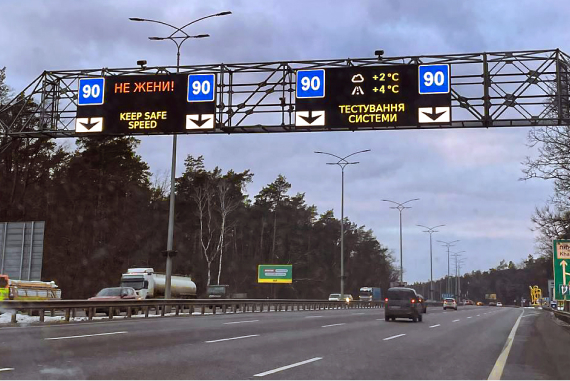Active VMS Traffic Signs
One of the factors that necessarily accompany the development of the transport network is the appearance of Dynamic Message Boards (DMB) and Variable Message Signs (VMS) on the roads. Installation of such signs allows to increase the carrying capacity of highways and traffic safety in difficult weather conditions.
Variable Message Signs (VMS) are devices designed to display information that may change depending on weather conditions or current road situation. Information is displayed according to previously prepared scenarios, taking into account general technical requirements for traffic signs and requirements for VMS construction.

Variable Message Signs can be:
- full-matrix traffic signs (intended for the display of informational messages and graphic information)
- contour traffic signs (for example, signs indicating the direction of movement with a reversing lane)
- traffic signs with elements of variable information (for example, signs indicating free parking spaces at the entrance to the city).
It should be understood that the role of a traffic control device is related to road safety and imposes very strict limitations on the quality and operational characteristics of the equipment.
The main document regulating the VMS characteristics is the EN 12966-2021 Standard – “Vertical Traffic Signs”. This standard is a harmonized EN 12966:2014 + A1:2018 European Standard.
All requirements for the VMS can be conditionally divided into several groups: photometric requirements, operational requirements, reliability requirements.
Photometric requirements are dictated by the need to ensure visibility, legibility and correct perception of information within the required viewing range. Photometric characteristics of traffic signs can differ significantly depending on the type of road on which the sign is installed. Thus, Variable Message Signs designed for use on highways must provide visibility at a long distance, which is usually achieved through the use of secondary optics, which allows the formation of a narrow light beam. Variable Message Signs designed for use in an urban environment, where visibility must be ensured only at short distances, should have a wide light beam and lower brightness.
Photometric properties include:
- Image brightness
- Colour coordinates of the colours used
- Brightness ratio (contrast) of the image
- Angle of light beam distribution
- Brightness uniformity of the display field
- Visible flickering
The first 4 characteristics are the main ones that determine the properties of the traffic sign depending on the place of its installation and are indicated by different classes.
L1, L2, L3 are the brightness classes. L3 is the highest class.
C1, C2 are the colour classes. C2 class has stricter limitations
R1, R2, R3 show the brightness ratio. R3 corresponds to the most contrasting type
B1 to B7 classes indicate the radiation angle. B7 corresponds to the widest radiation angle.
Taking into consideration the features described above, the main characteristics that should be taken into account when designing Variable Message Signs are:
- Equivalent sign area is a parameter, which is selected taking into account the size of the symbols to be displayed, which in turn is primarily related to the type of road and its speed regime;
- Pixel pitch is a parameter that depends primarily on the information viewing distance the and the type of displayed information;
- The maximum brightness of the display is a value that depends on the road type, the information viewing distance and the location of the VMS.
Based on the above information, it should be understood that the DMB and VMS cannot be considered a standard ready-made product: implementation of each object requires an individual approach and preliminary design. Our experience, the capabilities of national production and a powerful engineering team will allow us to implement projects of any complexity, taking into account the current European standards.